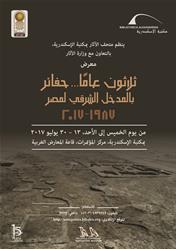Thirty Years of Excavation at the Eastern Gateway of Egypt (1987–2017) Exhibition
Posted on

The BA Antiquities Museum will host the “Thirty Years of Excavation at the Eastern Gateway of Egypt (1987–2017)” Exhibition, in collaboration with the Ministry of Antiquities, to highlight the vital military significance of the Eastern Gateway of Egypt,which dates back to ancient times. It will also highlight the archeological heritage—left behind by the numerous, successive civilizations that passed through Egypt—discovered by national and international archaeological expeditions and excavations carried out in the area during the past 30 years. The exhibition is going to be held from 13 to 30 July 2017 at the West Exhibition Hall, BA Conference Center (BACC).The opening will include a series of lectures to be held on 13 July 2017 at the BA Lecture Hall. During the lectures, researchers will present a number of research papers on the recent Egyptian archaeological discoveries made by archaeology expeditions in the heart of Suez Canal, the fortresses of Egypt, military architecture, and Egypt’s military history in order to highlight the history of the entire region and its military significance that has lasted to this day since ancient times.
The exhibition will display a number of illustrations, complemented by pictures and information, featuring the findings of Egyptian and foreign excavation expeditions in 15 archaeological sites, located to the east and west of Suez Canal. The displayed illustrations will also feature the discoveries found in North Sinai—mainly located on an ancient military road (Horus Way)that stretched from Egypt to Palestine—pertaining to the military fortresses and the history of military architecture since the Middle Kingdom of Egypt and through the Second Intermediate Period, the New Kingdom, the Late Period of ancient Egypt, until the Graeco-Roman Period. Over the years, the Egyptian mission unearthed a fortified city called Tjaru (or Tharo),at a site called Tell-Habwa to the east of Suez Canal, where several military forts that date back to the New Kingdom, royal palaces from the reigns of Thutmose II and Ramses II, central storage, granaries, administrative buildings, various royal reliefs depicting pharaohs of the New Kingdom, and other buildings and graves from the reign of the Hyksos were discovered. Additionally, the Egyptian-American mission unraveled forts that date back to the New Kingdom (the 18th and 19thDynasties)at Tell el-Borg.
The French mission discovered a fortified royal rest house dating back to the reign of Ramses II of the New Kingdom at Tell Abyad, and the Egyptian mission unearthed massive Late Period military fortifications at Tell el-Kedwa (Qedua).Throughout several years, the Egyptian-French mission at Tell al-Hayr uncovered several Persian and Greco-Roman military forts, a Roman camp within the fortification, administrative buildings, and a Ptolemaic bath. Over the course of several seasons, the Egyptian mission at Tell el-Farama (Pelusium) excavated a citadel, warehouses, a theater, a water storage plant, a wrestling arena, and an ancient Grecian stadium for horse racing (hippodrome) from the Roman period. At Tell el-Makhzan, located to the east of Pelusium, the Egyptian-Swiss mission discovered various Roman establishments and Byzantine churches. Furthermore, the Egyptian mission at Tell Abu Sayfi, located to the east of Suez Canal, unraveled Graeco-Roman military forts, a port on the Pelusiactributary of the Nile, a storage area, a large residential area, and a temple of the god Horus. At Tell Dafna, located to the west of Suez Canal, the mission discovered a citadel dating back to the reign of Psamtik I, a temple, a group of royal warehouses, an industrial area, and several fortified towers that overlooked a part of the Pelusiactributary of the Nile. Additionally, a large illustration of a military expedition, dating back to the reign of king Apries, was found in North Sinai. The Egyptian mission also discovered the tomb of Ken-Amun, who was an overseer during the New Kingdom (Ramesside Period),at Tell el-Maskhuta. Italian excavation works at Tell el-Maskhuta continued to unearth massive walls of the fortified city that date back to the reign of the 26thDynasty.
The exhibition will also present the suggested vision of a panorama of the history of the Egyptian military through the Eastern Gateway of Egypt. A documentary on the history of the exhibition’s excavations and their recent archaeological discoveries will also be screened at the event. Additionally, and as part of the exhibition's opening activities, the former Minister of Culture, the former Ministers of Antiquities, the heads of the Egyptian Antiquities Authority, and the former board of trustees of the Supreme Council of Antiquities (SCA) will be honored in recognition of their pioneering and enlightening role in conserving heritage and antiquities and in carrying out such a grand task throughout those 30 years.
To view the program, please click here.